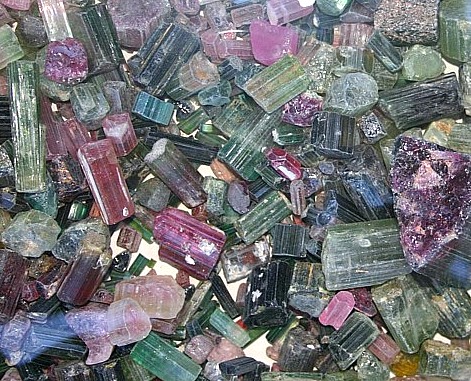
| TOURMALINE MINERAL FACTS |  |
|
| The Gem and Mineral Collector's Photo Gallery by Nevada Outback |
|
. Tourmaline Mineral Facts:
Chemical Formula:
(R9 Al3
(B-OH-F)2 Si4O19), where R is a
combination of: H, Al, Mg, Fe, Al, Cr, Fe, K, Na Colors: The color is varied, depending upon the composition. Common tourmaline with much iron is black, sometimes brown. More rarely light colored in fine shades of red, pink, green, blue, yellow, etc. Rarely white or colorless. A single crystal may show several different colors either arranged in concentric bands about the center of the crystal or in transverse layers along its length. Hardness: 7 to 7.5 Density: 2.98 to 3.2 Cleavage: None
Crystallography: Hexagonal Luster:. Its luster is vitreous.
Optics:
(Refractive Index): w = 1.6422; e = 1.6225; |
|
|
Composition,
Structure and Associated Minerals: 1. Alkali tourmalines, which are
colorless, red or green, and transparent. This variety is known as
Elbaite and it comprises most of the gem varieties. Tourmaline forms handsome crystals that are frequently characterized by possessing vertical striations and a triangular cross-section. They crystallize in the rhombohedral division of the hexagonal system and are hemimorphic (ditrigonal pyramidal class). The crystals are usually prismatic or columnar in habit, and are terminated by rhombohedrons. The name tourmaline comes from turamali, a name given to the early parcels of mixed gemstones from Ceylon. Tourmaline also forms one of the most beautiful of the semiprecious gem stones. The color of the stones varies, the principal shades being olive-green, pink to red and blue. Sometimes a stone is so cut as to show different colors in different parts. The green-colored stones are usually known by the mineral name, tourmaline, or as Brazilian emeralds. The red or pink stones are known as rubellite, while the rarer dark blue stones are called indicolite. |
|
|
|
Identification and Diagnostics Uses: The transparent varieties are used principally as gem stones, and the darker, translucent varieties in optical instruments. Fine crystal forms are valued as mineral specimens. As a gemstone, Tourmaline has gained a wide acceptance and become much more important in recent decades. |
Above: Tourmaline Crystal, Maine, USA |
|
|
Occurrence,
Localities and Origins: It is found also as an accessory mineral in metamorphic rocks, such as gneisses, schists and crystalline limestones. The black form of tourmaline is of widespread occurrence as an accessory mineral in metamorphic rocks. It may also occur as a gangue mineral associated with various types of ore bearing veins including copper, lead and cobalt minerals. In these metal deposits, the presence of tourmaline usually indicates formation at fairly high temperatures. Tourmaline is so common that an enumeration of its occurrence locations is impossible in a short article. The light colored, lithium bearing gem varieties are found in the pegmatite dikes associated with lepidolite. Famous woorld wide localities for the occurrence of the gem tourmalines are the island of Elba; at Campolonga, Switzerland; and Penig, Saxony, in the state of Minas Geraes, Brazil; in the Ural Mountains near Ekaterinburg; at several locations on the island of Madagascar. In recent years important finds have been made in Africa, including Tanzania and Nigeria. Most of these are found as deposits in pegmatite dikes, but in some locations, including Ceylon, Brazil and Madagascar, water rounded tourmaline has been recovered from detrital deposits formed from erosion of the dikes as well. In the US, gem tourmaline occurs at several points in western and central Maine; at Haddam, Conn.; and in San Diego Co., in California. The Maine localities are at Hebron, Paris, Poland and Auburn. The tourmalines are in pockets in pegmatites. The green varieties are most common, but all colors occur, and many crystals are variegated. It has also been mined at Haddam Neck, Connecticut. The centers of the gem industry in California are Mesa Grande, Pala, Rincon and Ramona in San Diego County, where many pink tourmalines and a few green crystals occur associated with the lithium mica, lepidolite, in pockets in a number of pegmatite dikes. Also in the United States, fine brown tourmaline crystals occur in the limestone at Gouverneur, N. Y. ; and handsome black ones at Pierrepont, N. Y. ; New Hope, Penn. ; and in Alexander Co., N. C. Return to the Mineral Collectors Information Page |
|
|
|
|
 Multiple Colors of Tourmaline Crystals |
|
|
Tourmaline Queen specimen, Pala, California |
Tourmaline with Quartz and Feldspar, Calif. |
|
|
|
|
|
.
Please note that the author, Chris Ralph, retains all copyrights to this entire document and it may not be reproduced, quoted or copied without permission.

NEVADA OUTBACK GEMS TURQUOISE AND JEWELRY